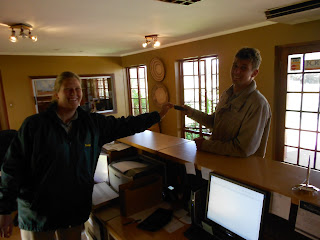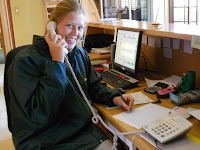The immune system is the body's defense against infectious organisms and other invaders. Through a series of steps called the immune response, the immune system attacks organisms and substances that invade body systems and cause disease. The cells involved are white blood cells (CD4+Tcells), which come in two basic types that combine to seek out and destroy disease-causing organisms or substances. Antibodies are produced and protect the body from future attacks.
HIV is a retro virus that primarely affects vital organs of the human immune system such as CD4+T cells, macrophages and dendritic cells. This virus takes the T-cells over and use it to make copies of itself. When all the copies are made inside the T-cells, they brake free destroying that cell and go to the next cell. This virus also mutates very quickely, since the reverse transcription from RNA to DNA is unstable. This means the virus quickely grows resistance to the body’s antibodies and medication.
If the CD4+T cell count are below 200 cellular immunity is lost. This is how they test if you have AIDS or not.
The window period is the period between the onset of HIV infection and appearance of detectable antibodies to the virus. This period takes about 3-4 weeks. If you test yourself for HIV in this period the results may be false, but you can still infect someone else.
The ELISA test is where they use the method of labeling the antibody. It is usually the first test used to detect for infection with HIV. If the antibodies to HIVare present, the test must be repeated. If the result is (-) another test is not needed, it has a low chance of having a false result in the window period.
If a mother has HIV she can transmit the virus to the baby during pregnancy, labour and delivery, or breast feeding.
Voluntary counseling and testing has helped millions of people learn their HIV status. You can get counseling when you get tested. If the results turn out to be (+) they tell you how to live a healthy lifestyle so the virus spreads slower. If you are tested (-), they tell you how to prevent the spreading of HIV. They also encourage people to get tested and know their status so you won’t spread it.
If you have HIV you become vulnerable to get oppertunistic infections, and can die from it. If you have a healthy lifestyle (do exersize) and eat right ( a lot of fruits and vegetables and less junk food) your immune system will stay good for a longer time.
The stages of HIV/AIDS are:
1. Primary HIV infect (window period, may have short flu-like symptoms)
2. Clinically asymptomic stage (last an average of 10 years, free from major symptoms)
3. Symptomatic HIV infection (immune system starts to fail, start getting oppertunistic infections)
4. Progression from HIV to AIDS (develop increasingly servere oppertunistic infections and cancers)
5. Death
Treatment
To treat HIV they use anti-retro viral treatment. It keeps the amount of HIV in the body at a low level (it doesn’t cure you from HIV, but gives you a longer time to live). It stops any weakening of the immune system. This treatment is very expensive, a lot of the people with AIDS can’t afford this medication. The state tries to help these people and give them the medicine or make it cheaper, they also don’t have enough money to give every one this medication.
Transmission
The HIV virus is transmitted through body fluids like blood, semen, vaginal fluids, preseminal fluids and breast milk. It can get transmitted if you have anal, vaginal and oral sex with an infected person, blood transfusions, using contaminated needles and mother to baby during pregnancy.
If a woman has unprotected sex and gets HIV the virus can easily be transmitted to the baby, during pregnancy, at birth or giving breast milk. If she wants to lower the risk of giving the baby HIV, she can have a Ceseran and don’t give the baby breast milk.
If you are abusing drugs, HIV can get transmitted if you share the needles with infected persons.
The blood they use for blood transfusions are tested so these days it is unlikely to get HIV through blood transfusions.
There are a lot of fears and misunderstandings about the transmission of HIV. HIV is Not Spread by:Mosquito Bites, Kissing, Laughing,Sharing, Toilets, baths, showers, Sneezing and Coughing, Food, Hugging andTouching,Swimming Pools, Shaking Hands, Sharing Plates, cups and saucers.
Something like kissing has a low risk of transmission, because a lot of mucus of an infected person needs to be transferred to get the other person infected, if there are cut on both of their tongues HIV can be transmitted but chances arte scarse
Prevention
To prevent the spreading of HIV You must have protected sex, be loyal to the person you are having sex with (one partner) or don’t have sex at all. Needles of drug abuse must not be shared, and if a mother knows she has HIV she must do every thing she can so the baby wouldn’t get it. This message of prevention must be told to all the people. They must be educated about HIV/AIDS.
In the workplace
The Code of Good Practice on key aspects of HIV/AIDS and employment is an excellent guideline in assisting employers to compile such a policy. The policy should contain acknowledgement that HIV/AIDS will be treated like any other life-threatening disease. It should encourage employees to be tested on a voluntary basis, at company expense, and should encourage employees to disclose their HIV status in confidence to the employer.
The policy must give assurances that confidentiality will be respected. Employers should arrange for education sessions for their employees to be educated on all the different tax rates of HIV/AIDS. The many myths that surround issues of HIV/AIDS are due only to a lack of education - employers will find it much easier to handle such issues in the workplace if the employees are properly educated on such matters.
Many employers introduce an Employee Assistance Programme, which can contain procedures for assisting employees with life-threatening diseases, and very importantly in terms of a certain percentage of the employee's salary being paid to the employee for as long as 12 or 24 months after the employee is no longer able to work.
People with HIV/AIDS may not be discriminated against in the workplace. There are a number of laws and
policies concerning people who have HIV/AIDS in the workplace, which should be read in conjunction with
the Constitution of South Africa.
HIV positive employees have the same rights and duties as other employees. They should not be
treated differently by employers or by co-workers.
Statistics
KZN-39.5%, MP-34.7%, FS-30.1, GP-29.8%, NW-30%, EC-28.9%, Limpopo-21.4%, NC-17.2%, WC-16.9, National-29.4%
Diferent age groups infected
Age | % infected with AIDS |
15-19 | 13.7 |
20-24 | 26.6 |
25-29 | 37.1 |
30-34 | 41.5 |
35-39 | 35.4 |
40-44 | 25.6 |
45-49 | 23.9 |
http://www,queerlif.o.za/test/news/25-latest/2919-hiv-a-aids-guide.html
http://www.health24.com/medical/condition_centres/777-792-841-1765,22075.asp
http://webmd.com/hiv-aids/human-immunodeficiency-virus-hiv-test
http://www.avert.org/mother.child_htm
http://kidshealth.org/parent/general/body_basics/immune.html
http://www.labourguide.co.za/general/hiv-aids-in-the-workplace-386
http://www.avert.org/stages-hiv-aids.htm
http://en.wikipedia.org/wik/aids
http://www.avert.org/aids-hiv-prevention.htm
http://www.avert.org/safricastats.htm

















































